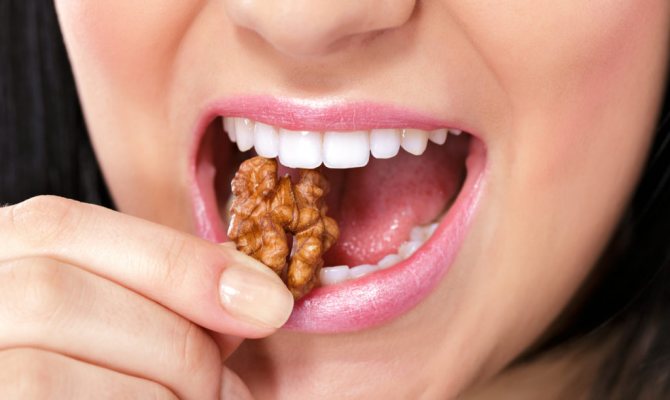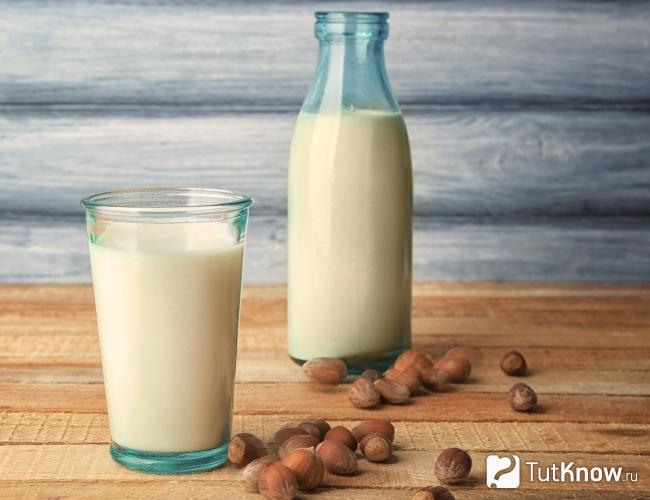During breastfeeding, a woman’s diet is very limited, since in the modern world most products in stores contain preservatives, dyes and other chemicals that are contraindicated for consumption. Walnuts are a natural product that can diversify the strict diet of a nursing woman.
Walnut is a natural product that is beneficial for mother and baby.
What is contained in walnuts and what properties do they have?
Walnut kernels contain components valuable for the body:
- fats, proteins and carbohydrates, as well as dietary fiber;
- useful macroelements - magnesium, potassium, sodium, calcium, chlorine, phosphorus and sulfur;
- microelements - copper, selenium, manganese, fluorine, iodine, cobalt, iron;
- antioxidants;
- amino acids such as arginine, cystine, leucine, phenylalanine, glycine, valine, in addition glutamic acid and aspartic acid, tyrosine;
- vitamins - A, P, K, B, PP, D, C and E;
- Omega 3 and Omega 6 acids, in addition - oleic and linolenic acids;
- essential oils;
- carotenoids;
- tannins.
The beneficial fruit has found application in medicine due to such properties as:
- Toning effect, general strengthening of the body and increased immunity.
- Restoration of the body after illnesses, in the postoperative period and after childbirth.
- Increase in hemoglobin levels.
- Treatment of atherosclerosis, as well as its prevention.
- Elimination of hypertension.
- Replenishment of cobalt salts, which promotes better absorption of iron in the intestines, and also serves as an important component for the normal functioning of the pancreas.
- Normalization of the functioning of the digestive organs.
- The effect of a laxative and anthelmintic.
- Diuretic action.
- Antispasmodic effect.
- Stabilization of the nervous system.
- Beneficial effects on brain function, mind and memory.
- Stabilization of hormone levels.
- Reducing the risk of developing tumors in the mammary glands thanks to the antioxidants included in the composition.
The greatest results can be achieved only with proper consumption of healthy kernels; you should not eat more than four nuts a day. An excess of the valuable fruit can provoke an inflammatory process in the tonsil area, irritation in the oral cavity, allergic stomatitis or diathesis, as well as migraine and vasospasm.
Is it possible to eat too many nuts?
Eating nuts is healthy because they can protect against risk factors for heart disease and other diseases, but it is also possible to eat too many nuts:
- Nuts are high in calories, so eating large amounts of nuts throughout the day can cause people to exceed their target calorie intake without realizing it - doing this "exercise" regularly can lead to weight gain.
- Nuts are also rich in healthy fats, which are good for the body in moderation, but in excess can cause diarrhea and other problems.
- Roasted, salted nuts can add at least as much sodium to your diet as other salty snacks. Anyone who eats salted nuts should pay attention to the label to see how much sodium they are eating. Raw or dry roasted nuts are a healthier alternative.
- Some people may find that nuts upset their digestive system. In this case, eating too many nuts may make them feel "bloated"; nuts are also a common food allergen.
Contraindications for use
No matter how useful the fruit is, not everyone can eat it. The main contraindications are:
- Allergic reactions.
- Blood clotting rates are too high.
- Acute intestinal diseases or disorders.
- Diseases associated with the pancreas.
- Diseases of the skin in the chronic stage - eczema, psoriasis, neurodermatitis.
- Problems with excess weight, obesity or tendency to be overweight.
Walnuts on the menu of a breastfeeding woman
First of all, keeping a strict diet and avoiding potentially allergenic foods is necessary only if the woman or baby has allergic reactions. Otherwise, the nutrition of a nursing mother should be based on her personal preferences, compliance with the norms and rules of food consumption.
Most ingredients should not be eaten only for the first time after childbirth, about a month. And then, you should not completely exclude any foods from the diet, it is enough just to reduce their consumption to the recommended norm, and you need to carefully monitor the child’s condition.
If the newborn tolerates many categories of foods well, then after the first month you can gradually try and introduce all the ingredients into your diet. Since a priori there is no product that causes problems for all children and mothers, if a mother knows that a particular ingredient causes her an allergy, she tries to eat it in minimal quantities so as not to harm herself or the baby.

Walnuts during breastfeeding will help a woman enrich her body with nutrients and beneficial substances.
The nut is not capable of significantly increasing lactation, but the healthy fruit can improve the quality of milk produced (see below) - the baby receives the necessary vitamins and quickly fills up with nutritious milk.
There is also the opposite opinion that an excessively viscous liquid can lead to stagnation in the milk ducts or mastitis. In practice, when consuming walnuts, milk becomes thicker, but not so much as to cause stagnation, but it is indeed a little more difficult for a child to suck such milk.
Of course, there are more positive qualities from eating walnuts during breastfeeding, but if the baby develops colic, rashes or allergies, the nursing mother should stop eating them.
Menu Introduction
Like any other ingredient, nuts are introduced into the menu slowly, starting with a small portion and with breaks between uses - from one small kernel for two days. At the same time, they look at the condition of the baby; if there is no colic, indigestion, rash or other signs of allergies, consumption can be continued and the portion increased.
You should eat walnuts with extreme caution when breastfeeding in the first month after the baby is born. In addition, you should not try jam, sweets with walnuts, fried kernels or nut butter. After heat treatment, nothing useful remains in them; rather, on the contrary, toxic oils appear, which can provoke a change in the baby’s condition or colic.
Recipes to increase lactation
Contrary to the well-known opinion that walnuts can increase the amount of milk produced, most doctors are confident in the opposite.
However, there is no doubt that walnuts are extremely useful during breastfeeding and can enhance the nutritional properties of mother's milk.
However, there are some folk recipes that, according to sources, increase the amount and fat content of milk:
- Take half a glass of peeled walnuts, pour 500 ml of boiled hot milk. Leave for 3-4 hours. Drink 1/3 cup of this infusion before feeding your baby (20 minutes before).
Please note that cow's milk often causes allergies and colic in the baby; it is better to use goat's milk. And in the first month after childbirth, consumption of dairy products is not recommended at all.
- Grate the carrots and mix with chopped walnut kernels. Eat the mixture 3 times a day, half a teaspoon.
It is not recommended to consume raw vegetables before the baby is 3 months old.
- Take a glass of chopped walnuts, pour liquid honey over them and add 2 tablespoons of melted butter, mix everything, let it brew for 2 hours. Take 1-2 teaspoon per day.
I would like to draw your attention to the fact that honey is a strong allergen and is strongly not recommended to be consumed before the baby reaches six months of age.
Storage process and selection features
Absolutely all varieties of walnuts await customers on the shelves - whole or crushed, with or without shells, in chocolate, etc. In any case, the appearance of the fruit must inspire confidence; it must be fresh, clean and appetizing. If some parameters do not correspond to this, it is better to buy nuts elsewhere.
Since the walnut is a fairly fatty fruit, improper storage can very quickly lead to a deterioration in its quality - the kernel will deteriorate, acquire a bitter taste and musty smell.
Therefore, it is better to purchase whole nuts, in shell; this is a natural protection for the fruit, which allows it to be stored longer.
At the same time, there should be no free space inside, such a nut is heavier in weight, and there should be no cracking sound when shaking, otherwise it will be a stale product. And the shell itself must be intact, without damage, cracks or any stains.
There should be no mold on the fruits, and if you choose peeled kernels, then you should take the nuts as a whole, in a well-packed container, since the smaller the nut, the sooner it will spoil. The color should be the same over the entire surface of the fruit, but if the kernels have a glossy, oil-like sheen, then most likely they have been stored for too long or incorrectly.
If you choose a chocolate product, then first of all you need to look at the shelf life, as well as the composition. It is better to buy packaging with the nearest release date and without unnecessary additives.
How to store
If you organize the storage process correctly, nuts can be stored for quite a long time. Basic storage tips:
- When storing fruits unpeeled, they are placed in a fabric bag, cardboard or wooden box. The temperature should be approximately 18 degrees, the place should be dark and dry, then the shelf life of the kernels will be from six months to a year.
- The peeled kernels should be placed in the refrigerator, but not kept for more than one month. You can put them in a glass, resealable container.
- If you need to store a large portion, it is better to put them in the freezer. Then in a well-closed container they will be stored for 2 to 6 months.
- During long-term storage, you periodically need to sort through the fruits and remove moldy ones.
How to change a breastfeeding mother's diet
First of all, mom should take care of the naturalness of all the products on her menu, which means:
- You will definitely have to give up canned foods and industrially produced confectionery products.
- Alcoholic, carbonated drinks and products containing artificial colors - juices, sweets, etc. are also excluded from the diet of a nursing woman.
- Sugar, salt and spices are added to dishes in small quantities and always one new component at a time. After which the baby’s reaction to the new composition of breast milk is monitored.
Signs that it is too early to introduce the product into the mother’s diet are:
- Rashes on the baby's skin in the form of a rash, redness in the folds.
- Diarrhea or constipation.
- Flatulence.
- Colic or bloating.
- Tearing.
- Clogged nose.
- Cough.
- Labored breathing.
If any of these symptoms occur, you should immediately consult a doctor and at the same time exclude the recently introduced product from your mother’s diet, at least for the near future.
Reducing your diet and eliminating many food groups should not lead to a decrease in calories. On the contrary, it is recommended that a woman’s daily menu during the feeding period should be composed of a high energy value – about 2700 kcal.
At the same time, experts advise adhering to the following ratios of nutrients: 55% carbohydrates, 30% fats and 15% proteins. Of course, it is difficult for a woman to maintain such a diet, especially given the exclusion of high-calorie confectionery and sweet packaged drinks.
Walnuts to increase milk production
Whether walnuts help with lactation or not is difficult to say, since there are opinions both for and against this. It has been established that the fat content of milk does not depend on them, but the quality does: nuts make it thicker, more viscous, and also contribute to its better absorption and saturate it with useful substances.
In addition, the elements contained in nuts have a beneficial effect on the baby’s nervous system, normalize sleep patterns, and protect the body from bacteria and viruses thanks to vitamin C, which improves immunity. This means that by consuming walnuts within normal limits, a nursing mother will only benefit her body.
Milk with walnuts for lactation is a recipe that is familiar to every woman during lactation. A drink that stimulates lactation is prepared as follows: walnuts are poured with boiling milk, about half a liter of liquid per half a glass of fruit, then infused in a thermos for about 4 hours .

This infusion is drunk all day, half an hour before the next feeding, about one third of a glass.
Beneficial properties of hazelnut milk

The unique combination of components present in the drink determines the benefits of hazelnut milk for the body:
- Sedative effect on the nervous system
. The product normalizes sleep, relieves chronic fatigue, reduces irritability, gives more energy and prevents outbursts of unmotivated aggression. - Activation of metabolic processes
. The components of hazelnut milk stabilize redox reactions, stimulate fat metabolism and accelerate the burning of excess calories. They also have choleretic and laxative properties. - Strengthening the immune system
. Helps the body to better resist the harmful effects of viral and infectious agents. It also makes it easier to combat allergies. - Normalization of the cardiovascular system
. Unlike animal milk, hazelnut milk does not contain saturated fat and cholesterol, so your blood vessels will not become clogged with plaque. The walls will strengthen, become more elastic, and the activity of the heart muscles will improve. Hematopoietic processes are also normalized and microcirculation is accelerated. - Strengthening tooth enamel
. Thanks to the presence of calcium and phosphorus, the drink accelerates the strengthening of bone tissue and restores it. - Positive effect on the gastrointestinal tract and stabilization of digestion
. The components of hazelnut milk have a good effect on the mucous membrane, preventing bloating, constipation and diarrhea. At the same time, the process of food absorption is normalized, heavy metal salts, free radicals, and toxins are removed. - Preventing the development of malignant tumors
. Thanks to the presence of paclitaxel, hazelnut milk inhibits the uncontrolled division of cells that are capable of invasion into adjacent tissues. - Accelerate muscle building
. It’s not for nothing that athletes include hazelnut milk in their diet. The drink promotes the production of the male reproductive hormone – testosterone. And thanks to the presence of protein, muscle fibers are formed and strengthened. - Improving breast milk production
. The components of the drink activate the mammary glands and make mother's milk more nutritious.
In addition, hazelnut milk has a positive effect on brain activity, memory, and the functioning of the adrenal glands and pituitary gland.
Walnut oil for breastfeeding
Walnut oil has a noble golden color, rich taste and a pleasant smell of nuts. This is an expensive pleasure and, moreover, quite rare; it is considered very aromatic and tasty among many other vegetable oils. The use of nut oil is not recommended for the following symptoms:
- individual intolerance;
- stomach or duodenal ulcer during exacerbation;
- gastritis in an acute state;
- liver related diseases.
It is not recommended to heat walnut oil, since when exposed to temperature, all the beneficial properties disappear, so it is not suitable for frying, but it is perfect as a dressing for main courses and salads.

Walnut oil is used not only for culinary purposes, but also in cosmetology, treatment and prevention of certain diseases.
Thanks to the valuable composition of healthy kernels, there is no need to ask the question whether nursing mothers can eat walnuts; rather, it is worth knowing in what quantity it is better to consume them without harm to the baby. After all, every mother wishes her child all the best and most useful.
Recipes with walnuts
To start, try the potato salad. It is extremely easy to prepare and most likely will not cause any discomfort to the baby.
Green bean salad can be tried starting from 4 months. However, remember that green beans belong to the legume family and can cause increased gas formation and, as a result, abdominal pain in the baby. Therefore, try a little at a time and watch your child’s reaction.
And if you really want something tasty and delicious, then try Plum Pie or Beetroot Muffins. Unfortunately, during heat treatment, walnuts will lose some of their usefulness, but you can cheer up by trying this deliciousness. This is also very useful for a young mother! The recipes contain flour, which is known to cause constipation, but to counter the flour there are plums and beets, which are known to promote bowel movements. It is recommended to prepare such recipes no earlier than 3 months after the birth of the child.
Carrot-buckwheat cake can be very healthy and tasty. In its preparation, buckwheat flour is used, which is a dietary product. In addition, this recipe is suitable for you if your child is allergic to gluten, because buckwheat flour does not contain gluten.
Only you can decide whether to eat walnuts or not. The main thing is not to overdo it and remember that nutrition during lactation should be rich and varied. Try the desired foods and carefully monitor your baby’s reaction.











